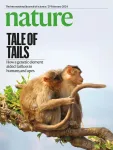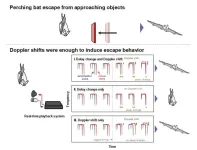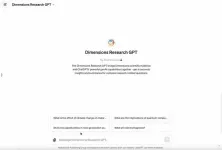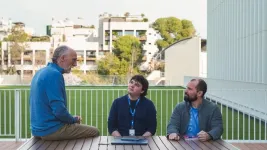(Press-News.org)
A microscopic battle rages in our bodies, as our cells constantly fend off invaders through our immune system, a complex system of cells and proteins designed to protect us from harmful pathogens. One of its central components is the enzyme cyclic GMP-AMP synthase (cGAS), which acts as a sentinel, detecting foreign DNA and initiating an immune response.
However, the immune system requires precise regulation to prevent cGAS from mistakenly attacking the body's own tissues, leading to autoimmune disorders, which now affect about 10% of the global population.
Previous studies have revealed a little of how this happens. During cell division – mitosis – the membrane that protects the cell’s nucleus, the nuclear envelope, breaks down and cGAS quickly relocates into the nucleus. There, it attaches itself to nucleosomes – the basic structural unit of DNA packaging in the cell – and becomes covered by another protein called BAF.
All this ensures that cGAS stays inactive and fixed in place, and does not mistakenly interact with the cell's own DNA. It represents a sophisticated balance between immune readiness and protecting the integrity of the cell’s genome. The question is, how does the cell coordinate this with its other everyday functions?
A new study from the group of Andrea Ablasser at EPFL sheds light on how cGAS is regulated, especially during the critical phase of cell division known as mitosis. The study is published in Nature.
The team used advanced imaging and molecular techniques to observe how cGAS is selectively broken down in the nucleus, preventing it from mistakenly responding to the cell's own DNA. They found that the process is mediated by a protein complex known as CRL5–SPSB3, which recognizes a specific motif in cGAS and tags it in the nucleus for destruction. Using structural biology, biochemistry, and cell biology, the researchers visualized the interactions between cGAS and the protein complex at the atomic level.
Specifically, CRL5–SPSB3 adds a protein called ubiquitin to cGAS. Ubiquitin – as the name suggests – is found ubiquitously across eukaryotic cells and one of its functions is to mark other proteins for death. The ubiquitination of cGAS also marks it for destruction, effectively inactivating the sentinel once the threat of an invader has been neutralized.
By elucidating the structure of the cGAS-SPSB3 complex, the study maps out how cGAS is regulated within the nucleus of cells, highlighting the sophistication of the immune system`s regulatory networks.
The implications also extend beyond basic science, allowing scientists to explore new strategies for treating diseases where the immune system is either overactive, such as in autoimmune diseases, or underactive, as in cases of chronic infections or cancer. For example, modulating cGAS activity could potentially enhance the effectiveness of cancer immunotherapies or provide new approaches to preventing autoimmune conditions.
Other contributors
EPFL Institute for Cancer Research (ISREC)
Reference
Pengbiao Xu, Ying Liu, Chong Liu, Baptiste Guey, Lingyun Li, Pauline Melenec, Jonathan Ricci, Andrea Ablasser. The CRL5–SPSB3 ubiquitin ligase targets nuclear cGAS for degradation. Nature 28 February 2024. DOI: 10.1038/s41586-024-07112-w
END
HOUSTON ― Researchers at The University of Texas MD Anderson Cancer Center built a new atlas of lung cells, uncovering new cellular pathways and precursors in the development of lung adenocarcinoma, the most common type of lung cancer. These findings, published today in Nature, open the door for development of new strategies to detect or intercept the disease in its earliest stages.
Led by Humam Kadara, Ph.D., professor of Translational Molecular Pathology and Linghua Wang, M.D., Ph.D., associate professor of Genomic Medicine, the team generated an atlas of around 250,000 normal and cancerous ...
A genetic change in our ancient ancestors may partly explain why humans don’t have tails like monkeys, finds a new study led by researchers at NYU Grossman School of Medicine.
Published online February 28 as the cover story of the journal Nature, the work compared the DNA of tail-less apes and humans to that of tailed monkeys, and found an insertion of DNA shared by apes and humans, but missing in monkeys. When the research team engineered a series of mice to examine whether the insertion, in a gene called TBXT, affected their tails, they found a variety of tail effects, including some mice born without tails. ...
New Haven, Conn. — A new Yale study finds an increased risk of hospital readmission for older Americans within 180 days of undergoing major surgery — a risk that is particularly acute for individuals who are frail or have dementia.
The findings were published Feb. 28 in the journal JAMA Network Open.
Previous research by the same Yale team demonstrated that major surgery is a common event for older Americans and also demonstrated a heightened mortality risk within one year of major surgery for people who are age 65 and older. The new study is the first to describe both the short-term risk (within 30 days) and longer-term ...
LA JOLLA, CA—Molecules often have a structural asymmetry called chirality, which means they can appear in alternative, mirror-image versions, akin to the left and right versions of human hands. One of the great mysteries about the origins of life on Earth is that virtually all of the fundamental molecules of biology, such as the building blocks of proteins and DNA, appear in just one chiral form.
Scripps Research chemists, in two high-profile studies, have now proposed an elegant solution to this mystery, showing how this single-handedness or “homochirality” could have become established in biology.
The studies were published in the Proceedings ...
PARIS, France and BEER-SHEVA, Israel, February 28, 2024 – The James Webb Space Telescope (JWST)[1], developed by NASA and ESA, has just obtained the first spectra of very low-mass galaxies less than a billion years after the Big Bang. A technological feat made possible by the unique combination of JWST sensitivity and the gravitational lensing effect of the Abell 2744 cluster: nearby galaxies act like cosmic magnifiers, distorting space and amplifying the light of background galaxies. By demonstrating that small galaxies are very likely at the origin of the reionization of the universe, this discovery represents a major breakthrough in our knowledge of the cosmos.
The international research ...
People who have had a kidney transplant are at high risk for developing skin cancers. New research directed by investigators from the Johns Hopkins Kimmel Cancer Center is exploring the best combination of treatments to target skin cancers while preserving the transplanted organs.
Now, they report results from a clinical trial testing a novel drug combination designed to stimulate the immune system to fight advanced, potentially lethal skin cancers while not permanently damaging patients’ transplanted kidneys. The treatment included two immune-suppressing drugs ...
Unlike most animals that rely on visual senses, bats navigate and locate prey or obstacles through echolocation. By emitting sounds and comparing them to the reflected echoes, bats can “visualize” movement in the environment. When sound waves encounter a moving object, they can undergo changes such as a Doppler shift in frequency or experience a delay, which the bat can sense. However, it is unclear which acoustic characteristics bats rely on to detect moving objects.
Japanese horseshoe bats (Rhinolophus ferrumequinum nippon) emit ultrasound pulses that are characterized ...
Digital Science is pleased to announce the launch of two new products – Dimensions Research GPT and Dimensions Research GPT Enterprise – bringing the unmatched, trusted research coverage of Dimensions to the ChatGPT platform.
Users can get AI-generated answers to research-related questions on the GPT platform informed by Dimensions’ huge database, making ChatGPT more research-specific for topic exploration.
Available to users of both the free and paid Dimensions Analytics web application, Dimensions Research GPT and Dimensions Research GPT Enterprise help overcome ...
(Boston)— Knee osteoarthritis (OA) is the most common form of arthritis, affecting approximately 600 million people worldwide and 34 million people in the U.S. There are no treatments available that prevent its progression to date. Recommended pharmacological treatments for symptoms have either small-to moderate effects or short-term effects, often with side effects, and lifestyle behaviors such as exercise and weight loss are under-utilized.
Historically, intra-articular mineralization (IAM) or calcium crystal deposits in the joint, were thought to be of no clinical consequence, and perhaps just something that happens with older ...
An international team of scientists led by ICREA researcher and Director of the Life Sciences Department at the Barcelona Supercomputing Centre - Centro Nacional de Supercomputación (BSC-CNS), Alfonso Valencia, has developed a technology based on artificial intelligence (AI) for the study of minority diseases and has successfully applied it to identify the possible causes of the appearance of what are known as myasthenic-congenital syndromes, a group of rare inherited disorders that limit the ability to move and cause varying degrees of muscle weakness in patients.
The lack of available data on minority, also known as rare, diseases makes research in this area extremely ...





